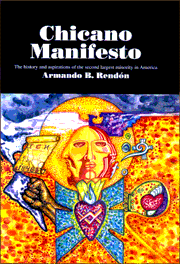


Chicano Manifesto, the book that captured a cultural movement as it happened, is now available again in a 25th Anniversary Edition, its publisher, Ollin and Associates, Inc., announced today. Chicano Manifesto, written by Armando B. Rendón, was originally published by Macmillan Company in 1971, the first book about the Chicano Movement written by a Chicano. When this book first appeared, Chicanos were unknown in America as a social and political force. The book describes how five major uprisings seeking cultural awareness and social justice erupted throughout the Southwest in the mid-1960s and evolved into a single reality known as the Chicano Movement.
The book is biographical in many ways--not only was much of the history of the revolution, persons and events, recorded because the author was there, but his own evolution as a Chicano, and perhaps of other Chicanos, is reflected there as well.
Rendón points out that the most disturbing revelation new readers of the book may find is that so much of the social, economic and political concerns Chicanos confronted a quarter century ago still persist. Manifesto enlightens our understanding of what happened in the late Sixties and provides a starting point for asking why these gaps exist now. As the author points out, Chicanos today face a level of racial hatred and fear that is perhaps even more intense and open and from more sectors of society than even the most visionary Chicano leaders could have foreseen.
This anniversary edition contains a new prologue but, most crucially, a legal analysis written by the author, interpreting the Treaty of Guadalupe Hidalgo as a living human rights document. The document adds a new dimension to the study of the Treaty as well as renewed activism by Chicanos in the field of human rights.
Manifesto still serves as a clarion call for action, but sounding out now for a renewed Chicano activism propelled by a vision of the Chicano as clearly the most important person in the evolution of the peoples of the American continents. Not only is the Chicano a composite of the vast diversity of peoples in the Americas, but, as the author points out in a new prologue, the largest indigenous ethnic group in the United States of America and thus a bridge between the American nations.
Rendón at present is an activist in human rights law, a co-founder of the National Chicano Human Rights Council, of which he is a Board member, and the leading proponent of the Treaty of Guadalupe Hidalgo as a living human rights document. He is currently working on a book about the evolution of the Chicano Movement into an indigenous peoples cause.
A native of San Antonio, Texas, he now resides in Northern California. Sal Garcia, a San Francisco artist, did the cover art.
To order Chicano Manifesto, please complete the order form.